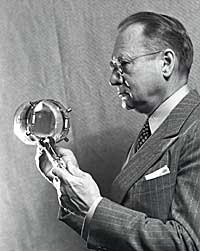Vladimir Zworykin: Difference between revisions
No edit summary |
No edit summary |
||
| (11 intermediate revisions by 3 users not shown) | |||
| Line 1: | Line 1: | ||
== | == Biography == | ||
<p>[[Image:Zworykin.jpg|thumb|right|Vladimir Zworykin holding an iconoscope. Courtesy: Thomson Multimedia (RCA).]] </p> | |||
<p>Born: 30 July 1889 <br></p> | |||
<p>Died: 29 July 1982 </p> | |||
< | <p>By the 1970s, the oft-called Father of Television Vladimir Zworykin parked his 21-inch [[RCA (Radio Corporation of America)|RCA]] TV in the corner of a room and rarely turned it on. He was not fond of the shows. But without him, we would not have TV as we know it today. In 1924, he created the [[Iconoscope|iconoscope]], the first practical, all-electronic television camera tube. In 1929 he invented an important part of the receiver called the kinescope, a cathode-ray picture tube. Zworykin’s work moved television away from mechanical systems and his contributions to electronic television are immense. </p> | ||
[[ | <p>Zworykin was born in Russia on 30 July 1889. He was interested in television his entire career. As a young engineering student, he worked for physicist Boris Rosing who was trying to send pictures through the air. In 1919, following the Russian Revolution, Zworykin moved to the United States. He worked at Westinghouse Electric Corporation in Pittsburgh. In 1929, when Zworykin didn’t get the support or encouragement he needed to build electronic televisions, he moved to [[RCA (Radio Corporation of America)|RCA]]. With the strong support of [[RCA (Radio Corporation of America)|RCA’s]] head [[David Sarnoff|David Sarnoff]], another Russian immigrant, Zworykin continued developing electronic television. His all-electronic television system was introduced to the public at the 1939 New York World’s Fair. </p> | ||
< | <p>Zworykin’s and RCA’s work was directly challenged by the patent claims of [[Philo T. Farnsworth|Philo T. Farnsworth]] who also worked on electronic television. Farsworth won a major patent suit against RCA in 1939 and Zworykin’s designs for electronic TV would not be considered the first. Despite the legal battle, Zworykin’s contributions to televison were great. And while some may have called him Father of Television, Zworykin always said that television was the creation of hundreds of inventors and researchers. Zworykin's own contributions were recognized by the [[AIEE History 1884-1963|AIEE]] who awarded Zworykin its [[IEEE Edison Medal|Edison Medal]] in 1952 'For outstanding contributions to concept and design of electronic components and systems.' He died on 29 July 1982 in Princeton, New Jersey. </p> | ||
== Further Reading == | |||
<p>[[Oral-History:Vladimir Zworykin|Vladimir Zworykin Oral History]] </p> | |||
[[Category: | [[Category:Components, circuits, devices & systems|Zworykin]] [[Category:People and organizations|Zworykin]] [[Category:Inventors|Zworykin]] [[Category:Communication equipment|Zworykin]][[Category:TV equipment|Zworykin]] [[Category:Communications|Zworykin]] [[Category:Electron devices|Zworykin]] [[Category:Cathode ray tubes|Zworykin]] [[Category:Photoelectricity|Zworykin]] [[Category:Bioengineering|Zworykin]] [[Category:Medical services|Zworykin]] [[Category:X-rays|Zworykin]] [[Category:News|Zworykin]] | ||
[[Category:Bioengineering]] | |||
[[Category: | |||
[[Category:X-rays]] | |||
Revision as of 19:59, 2 March 2012
Biography
Born: 30 July 1889
Died: 29 July 1982
By the 1970s, the oft-called Father of Television Vladimir Zworykin parked his 21-inch RCA TV in the corner of a room and rarely turned it on. He was not fond of the shows. But without him, we would not have TV as we know it today. In 1924, he created the iconoscope, the first practical, all-electronic television camera tube. In 1929 he invented an important part of the receiver called the kinescope, a cathode-ray picture tube. Zworykin’s work moved television away from mechanical systems and his contributions to electronic television are immense.
Zworykin was born in Russia on 30 July 1889. He was interested in television his entire career. As a young engineering student, he worked for physicist Boris Rosing who was trying to send pictures through the air. In 1919, following the Russian Revolution, Zworykin moved to the United States. He worked at Westinghouse Electric Corporation in Pittsburgh. In 1929, when Zworykin didn’t get the support or encouragement he needed to build electronic televisions, he moved to RCA. With the strong support of RCA’s head David Sarnoff, another Russian immigrant, Zworykin continued developing electronic television. His all-electronic television system was introduced to the public at the 1939 New York World’s Fair.
Zworykin’s and RCA’s work was directly challenged by the patent claims of Philo T. Farnsworth who also worked on electronic television. Farsworth won a major patent suit against RCA in 1939 and Zworykin’s designs for electronic TV would not be considered the first. Despite the legal battle, Zworykin’s contributions to televison were great. And while some may have called him Father of Television, Zworykin always said that television was the creation of hundreds of inventors and researchers. Zworykin's own contributions were recognized by the AIEE who awarded Zworykin its Edison Medal in 1952 'For outstanding contributions to concept and design of electronic components and systems.' He died on 29 July 1982 in Princeton, New Jersey.
